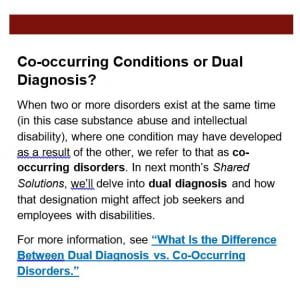As an employment consultant, you see and work with a wide variety of clients. You have the opportunity to find jobs and change the lives of each individual who knocks on your door (or, lately, your cyber door), regardless of their disability, their culture, their race, their gender, their previous job history or lack thereof, or even their involvement in the judicial system.
As a part of our ongoing discussions about equity, diversity, and inclusion, staff from the Center on Community Living and Careers recently asked Seena Skelton, Ph.D., director of Operations of the Midwest and Plains Equity Assistance Center, about how to support individuals who may have a different race, culture, religion, gender, or identity than yours. In this post, we want to share some of Dr. Skelton’s recommendations with you.
Creating a Safe Space
First, let individuals know you’re creating a “safe space” so that together, you can discuss some of the challenges they may be concerned about experiencing in their new work place. Don’t position yourself as the authority. Instead, build trust by assuring them  that you are learning too. Working together, you can explore any concerns or questions they may have and find answers or determine how to handle certain situations.
that you are learning too. Working together, you can explore any concerns or questions they may have and find answers or determine how to handle certain situations.
Aside from the concerns and the practical questions they may have about job duties, schedules and rules, job seekers may have apprehensions about how they will fit in and whether or not they will face discrimination. They may also be anxious about other issues, some seemingly small, but which may be just as important to them. Be open to discussing things like:
- foods (mohinga, by the way, is a fish-based soup with rice noodles popular in Burmese cuisine),
- hairstyles,
- wearing a hijab or other item of religious tradition,
- language,
- fasting for religious holidays,
- sharing conditions of probation with co-workers,
- politics of co-workers that might be considered offensive,
- and much more.
Learning About Identity
 Whatever their goal, their concerns, or their questions, learn as much about their identities as you can, because this may give you some insight into their thought processes and priorities. Leave your stereotypes and judgment at the door, though. Let them teach you.
Whatever their goal, their concerns, or their questions, learn as much about their identities as you can, because this may give you some insight into their thought processes and priorities. Leave your stereotypes and judgment at the door, though. Let them teach you.
As you position yourself as the learner, encourage job seekers and employees to share their apprehensions and feelings with you and let them discuss some of their challenges so that together you may diminish some of their fears or anxieties and collaborate to generate some solutions.
Always follow up by asking them, “What else is it I need to know about _____? Am I missing anything?”
Special Note: Dr. Seena Skelton will be a keynote speaker and featured presenter at Facing the Future Together, July 21-23, our virtual, statewide transition conference. More information coming soon!
Resources
- Intersectionality and Disability—a video from Kari Gray, defining intersectionality and the importance of recognizing multiple identities.
- Intersectionality of Identities with Disability—National Center for College Students with Disabilities (NCCSC) Clearinghouse and Resource Library









